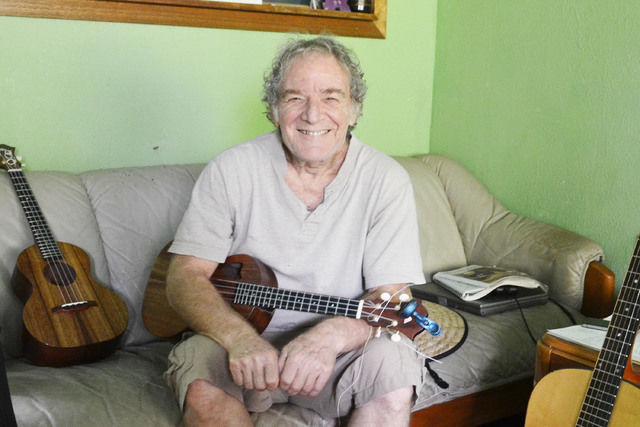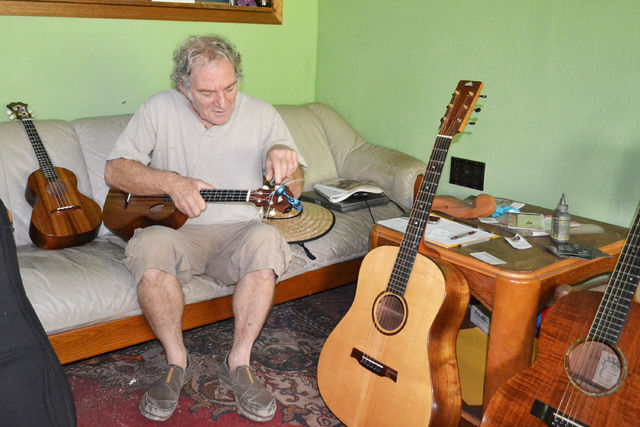Musicians Raymond Kane, Roland Cazimeros, Larry Ramos and Bob Weir have one thing in common: They all play instruments made by Michael Sussman.
For 40 years, Sussman has been building and restoring koa instruments on Kauai. From guitars and ukulele to violins, Sussman has come a long way since he first moved from California in 1972 and made his home and work base in Anahola in 1976.
Much of the Hawaiian music coming out of Kauai in the ‘70s and ‘80s was probably played with an instrument from Sussman or the Kamaka family.
These days, Sussman continues to make ukulele in the heart of the forest and cares for a healthy number of koa trees.
With clients worldwide, Sussman has produced more than 400 guitars, violins and ukulele, and restored more than 400 historical instruments.
When did you come to Kauai?
First time I came was around 1964 and then I came back in 1972 with my trunk of tools and a couple of instruments.
What brought you to Hawaii?
I had some friends over here and it was different then. There was one radio station. There was one traffic light. Not a lot of people knew about Kauai then unless you were a surfer or if you had friends from here or had family here.
When you moved to Kauai, what was your focus with work?
It was the end of the ’60s and it was still the dulcimer craze. It was an easy instrument to make, but it was popularized by some very special musicians. Richard Ferina, who died in a car accident when he was 25, made some really beautiful recordings. So I had wood for those instruments, so I came over and ended up in Hanapepe and was honored with the presence with the braddas who all played instruments, played guitar and Hawaiian music and the ukulele. So I started making ukulele and then they brought me the koa.
Actually, I knew about the koa before I came here. The koa was part of the reason why I came here. I knew somebody in California who had a koa Weissenborn steel guitar from the ’20s. It was his prized instrument. When he heard I was thinking about moving over here, he had me come check out his koa Weissenborn and he told me the story of the koa. That it grows over here. He knew I was making the instrument out of the native trees.
I always had this connection with the forest and people were always giving me their best trees, so I had walnut and I had maple. Those were my two trees of choice unless you lived in the tropical.
That’s what I used to make my first few instruments: walnut and maple. Then I came over here and when I found out where the koa grew.
How long were you in Hanapepe?
I was in Hanapepe until 1976. We moved out here to Anahola. I had the lease on the old pool hall and I had my shop in the middle of it. I moved in with my tools.
What were some of projects you started in Anahola?
By that time, I was making guitars and I had koa and I was making ukulele. Then I met Momi and George Kaliohi. George had a special Martin ukulele. It was one size bigger than a baritone with a spruce top and a Brazilian rosewood, and I made a model after that, and I was making that one for a while. I was calling that the big uke. There’s a few of those around. Then I started learning of the history of the ukulele and became intrigued with the whole thing and the masters were still performing: Eddie Kamae, Dennis Kamakahi, who recently passed away, even Gabby (Pahinui) was performing over here. It was just a lot of musicians available. It was a different era. I was blessed to be born at that time, where the musicians were still accessible.
These guys were available and I used to take them my first few instruments. They had to put up with me, but they did. They were very kindhearted to me, I must say. All of them.
What does the ukulele mean to you?
It’s a little bit like the kalo. It’s one of the few things the Hawaiians still have. It carries all this history and it comes from the forest. It’s Hawaiian heritage and something to be passed on and also something that should be given its deserved place in the scheme of things. It’s one of Hawaii’s main public trusts: music and the compositions. History was also passed on through music for a long time. There’s the Hawaiian renaissance that most of the people who were involved were all musicians and half of them were the composers of these very songs that’s everyone’s playing now. Songs that can teach people how to live.
I’m an enabler. I never really sold stuff to stores. I attempted here and there, but I always mostly sold things to people. Even though I didn’t play, all my friends played and all my family played. It’s part of my culture. It’s part of my DNA. I’m part of music’s contribution.
How many instruments have you made in your lifetime?
I’ve probably only made 400 to 500 instruments. That’s considered a good amount. That was considered a standard.
What was it like when ukulele weren’t mass produced?
There was a time when people used to come down here regularly. They used to just show up. They heard there was a guitar maker, an uke maker, and they would just show up — any musicians or anybody who played or anybody wanted to experience — for 30 years. I never had to do anything but work. I had incredible people down here. I do remember everyday the people who used to be down here. All the instruments have a story, all the trees have a story, all the songs have a story. That’s what the instrument maker is left with. The player gets the instruments; the instrument maker gets the money. The instrument maker is left with the story of the song, and the story of the player. I’m left with these incredible memories. It was like a renaissance for many years. There was never ukes available besides me and Kamaka when I came here. Either that or it was a plastic uke from somewhere.
How much wood do you use to make, let’s say, one tenor?
About 4 feet. Not that much. They’re cut out of bigger pieces. It’s mostly the labor, but it’s not easy getting koa if you want the traditional Hawaiian sound.
How difficult is it to get koa on Kauai?
You can find it. There’s not that much available on Kauai, but the Big Island there’s koa you can buy for instruments. Everybody has a little bit of koa. What’s cool, though, is that more and more people are reforesting, which is part of the responsibility of the maker. People are making serious attempts to reforest.
You started an initiative, haven’t you?
I just got approved for another project from the Department of Agriculture. It’s an agroforestry project. I’m one of the first. I got koa down here. I grow koa and I reforest my own. I’m available for that, too. I’ve been thinking more of taking care of the land here because this place is awesome.
What kind of trees do you have here?
I probably got 100 koa. I got fruit trees, avocados, citrus, bananas, macadamia nuts. I love being outside the shop, taking care of the trees. My trees are getting 10-15 years old now. They’re turning into gorgeous trees. That’s what’s equally important to me.






